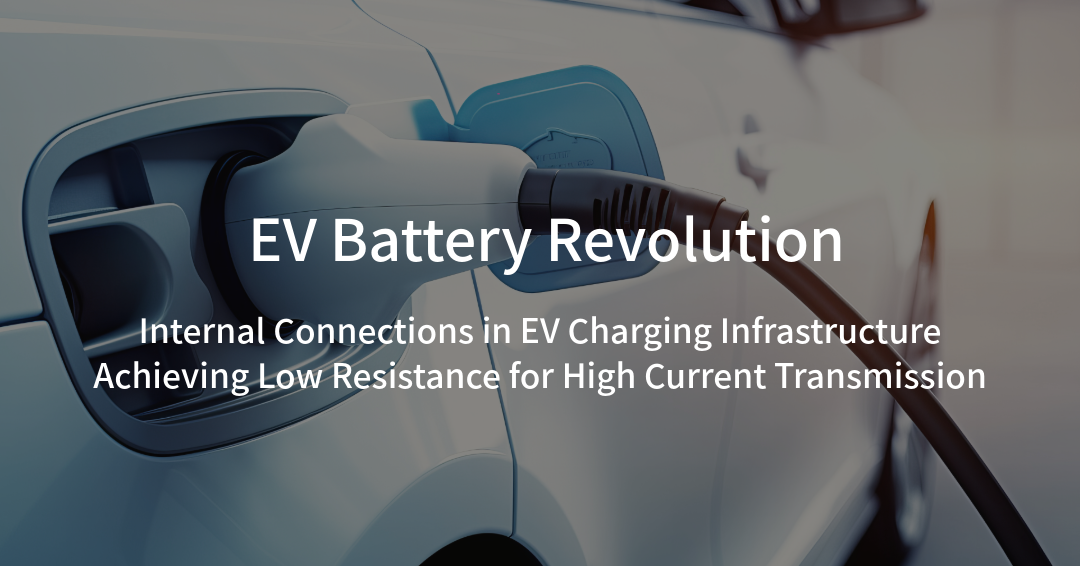As EV adoption accelerates, not only batteries but also charging infrastructure must evolve. The recent emergence of high-power, multi-hundred-kilowatt fast chargers means a full charge is possible in just minutes. However, the surging current levels inside these chargers have amplified a critical issue: reducing heat generation caused by electrical resistance at wiring joints.
table of contents
The Challenge Posed by High Current Transmission
Fast charging infrastructure constantly routes massive currents, often exceeding hundreds of amperes, through its internal components.
This high stress leads to several problems:
- Degradation and Efficiency Loss: Conventional joining quality is inadequate, leading to heating, material degradation, and reduced charging efficiency.
- Safety Risks: Heat buildup can degrade insulation and increase the risk of melting (fusing), compromising safety.
- Increased Cost: Extensive cooling and safety measures add significant costs, lowering the overall price competitiveness of the infrastructure.
Traditional methods—crimping, bolting, and welding—have long been used, but they suffer from aging degradation, high cost, and inconsistent weld quality.
LINK-US's Solution: Ultrasonic Complex Vibration Bonding (UCVB)
The Ultrasonic Complex Vibration Bonding (UCVB) developed by LINK-US is the ideal solution for high-current transmission in charging infrastructure.
Unlike conventional fusion processes, UCVB uses solid-state bonding without melting the materials. This resolves the quality and cost issues inherent in mechanical fastening and fusion welding.
- Resistance Reduction: Achieves high electrical conductivity regardless of the material combination (similar or dissimilar).
- Minimal Thermal Impact: Minimizes microstructural changes, preserving the base material's physical properties.
- Enhanced Reliability: Suppresses the formation of brittle intermetallic compounds, leading to superior resistance against aging degradation.
- Process Simplification: Eliminates spatter-related cleanup, downtime, and rework.
With a particular strength in joining copper and aluminum, UCVB offers major advantages for building charging equipment that demands lower weight and lower cost.
Specific Applications within EV Chargers
UCVB is applicable to various internal structures of charging infrastructure:
- Busbar Joining: Ensures low resistance and low heat generation in high-current transmission paths.
- Wiring and Terminal Connections: Delivers highly reliable connections capable of withstanding repeated charging cycles.
- Joining with Cooling Structures: Direct bonding without the need for braze materials provides superior heat dissipation.
By implementing UCVB, manufacturers can simultaneously achieve improved safety, efficiency, and size reduction inside the charger.
Impact and Benefits
Introducing UCVB in EV charging infrastructure yields powerful results:
- Increased Efficiency and Energy Savings: Reduced heat generation from electrical resistance lowers the load on cooling systems.
- Improved Safety: Decreases the risk of cable burnout, fire, and other accidents.
- Smaller, Lower-Cost Infrastructure: Reduces the need for oversized cooling units and safety margins, strengthening the cost competitiveness of charging equipment.
- Extended Lifespan and Reduced Maintenance: Maintains stable performance over long periods, outlasting the faster-degrading performance often associated with mechanical fastening (crimping).
Future Outlook
The EV charging infrastructure is moving toward new technological trends like Ultra-Fast Charging (350kW+) and Vehicle-to-Grid (V2G) bidirectional charging. These trends impose even greater current stress, escalating the demands on joining technology.
LINK-US's UCVB has the potential to become the standard for low-resistance, high-reliability joining, even in these challenging, high-load environments of the future. It is undoubtedly a key technology supporting the "unseen parts" of charging infrastructure as the EV market expands.
Summary
The rapid deployment of fast-charging infrastructure is vital for the EV society, but it hinges on a core technical challenge: how to handle high currents safely and efficiently.
LINK-US's Ultrasonic Complex Vibration Bonding overcomes traditional limitations to deliver low-resistance, high-reliability joints, supporting the next evolution of charging infrastructure.
→ If you are facing high-current joining challenges, contact LINK-US for a consultation.

